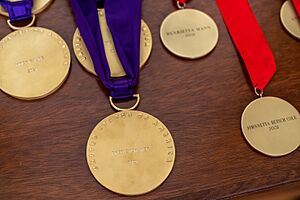Henrietta Mann facts for kids
Quick facts for kids
Henrietta Mann
|
|
|---|---|
| Born |
Henrietta Verle Mann
1934 (age 91–92) |
| Other names | Henri Mann, Henri Mann Morton, Henrietta Whiteman |
| Citizenship | Cheyenne and Arapaho Tribes, United States |
| Occupation | academic, activist |
| Years active | 1954–present |
Henrietta Verle Mann (born in 1934) is a respected Native American teacher and activist. She is a member of the Cheyenne and Arapaho Tribes. Henrietta helped create special study programs about Native American cultures at several big universities. These include the University of California, Berkeley, the University of Montana, and Haskell Indian Nations University.
In 2000, she made history as the first American Indian to hold a special teaching position in Native American studies at Montana State University. She also received the Montana Governor's Humanities Award. Henrietta retired from teaching in 2004. After that, she became a special advisor to the president of Montana State University.
Early Life and Education
Henrietta Verle Mann, also known as "Henri," was born in 1934. Her hometown was Clinton, Oklahoma. Her parents, Lanora E. and Henry Mann, were part of the Cheyenne and Arapaho Tribes of Oklahoma. Her father was a farmer who raised cattle. Her mother took care of chickens.
Henrietta's great-grandmothers were very important. One was White Buffalo Woman, who survived the terrible Sand Creek massacre. The other was Vister, who survived the Washita Massacre. Henrietta's mother was Christian, but other family members followed traditional beliefs. They also practiced the Native American Church ways.
Henrietta's first language was Cheyenne. Even after she started school, an aunt visited daily. She taught Henrietta about Cheyenne culture after school. Henrietta finished high school in 1950. Then, she went to Southwestern State College in Weatherford, Oklahoma.
In 1954, she earned her bachelor's degree in English. Her parents gave her an Indian name: "The Woman Who Comes to Offer Prayer." She later married Alfred Whiteman and had four children. Alfred passed away in 1980.
Career and Contributions
Henrietta Mann became an elected member of her Tribal Council. She helped write a federal law that led to a $15 million payment for her tribe in 1967. This was part of settlements from the Indian Claims Commission. She strongly believed in creating Native American studies programs. These programs would help American Indians learn about themselves. They would also help them gain control over their own future. She was the first president of the Cheyenne and Arapaho Tribal College.
In 1970, Henrietta earned her master's degree in English literature from Oklahoma State University. She then joined the faculty at the University of California, Berkeley. She helped create the first-ever degree program for ethnic studies in the United States. In the same year, she helped start the National Indian Women's Action Corps. This group aimed to empower Native American women.
In 1972, she moved to the University of Montana in Missoula. There, she directed the Native American Studies program. She was a key person in designing the courses. She taught at the university for 28 years.
Henrietta continued her education as a Danforth Fellow. She earned her PhD in American Studies from the University of New Mexico in 1982. That year, she was named Cheyenne Indian of the Year. Between 1986 and 1987, she taught at Harvard University. She also worked for the Bureau of Indian Affairs' Indian Education Office. She was the first American Indian woman to lead Indian education programs. In 1987, she was named Indian Woman of the Year.
In 1991, Henrietta stepped down as director of the Native Studies Program. She became a professor, which gave her more time to write. That year, Rolling Stone magazine named her one of the top ten professors in the United States. She often spoke across the country about Indian education. From 1993 to 1994, she helped design a Native American Studies Program for Haskell Indian Nations University.
Around 1998, Henrietta started using her maiden name, Mann, again. In 2000, she received the Montana Governor's Humanities Award. In 2001, she moved to Montana State University (MSU). She became the first person to hold a special teaching position in Native American Studies at MSU. She retired from teaching in 2003. After that, she became a special advisor to the president of Montana State University.
She also served as a trustee for the Smithsonian's National Museum of the American Indian. This museum opened in 2004. In 2008, she received a lifetime achievement award from the National Indian Education Association. In 2016, she became one of only two American Indians elected to the National Academy of Education.
On March 21, 2023, President Joe Biden presented Henrietta Mann with the National Humanities Medal. This is one of the highest honors in the nation. Henrietta Mann is recognized for greatly improving Native American studies in colleges and universities.


